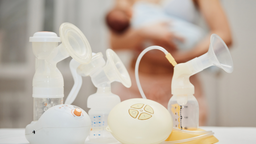
We know that many of you pump your milk, either for work or for occasional times away from your babies
We also know that figuring out how long your milk can safely stay on the counter, in the fridge or a cooler, and in the freezer can be a confusing process.
In an attempt to reduce the confusion, we looked at the many available breast milk storage guidelines, and are sharing the most recently updated guidelines from the Academy of Breastfeeding Medicine. The Academy is an organization or physicians dedicated to supporting breastfeeding.
These guidelines are current and well referenced, are more specific (showing optimal and acceptable storage lengths) than other sets of guidelines, and are recognized by the Centers for Disease Control. La Leche League’s guidelines‘s are quite similar. They are intended for use with full term infants.
Milk Storage Guidelines, Academy of Breastfeeding Medicine Clinical Protocol #8, revised March 2010
| Location | Temperature | Optimal storage length | Acceptable storage length |
| Room temperature | 60-85°F (60-29°C) | 3–4 hours | 6–8 hours acceptable under very clean conditions |
| Refrigerator | 39°F (<4°C) | 72 hours | 5–8 days under very clean conditions |
| Freezer | 0°F (<-17°C) | 6 months | 12 months |
| Small cooler with ice pack | 59°F (15°C) | n/a | 24 hours (though evidence is poor) |
Additional notes:
“Previously frozen human milk that has been thawed for 24 hours should not be left out at room temperature for more than a few hours.”
“Once a baby begins drinking expressed human milk, some bacterial contamination occurs in the milk from the baby’s mouth. The duration of time the milk can be kept at room temperature once the baby has partially fed from the cup or bottle would theoretically depend on the initial bacterial load in the milk, how long the milk has been thawed, and the ambient temperature. There have been no studies done to provide recommendations in this regard. Based on related evidence thus far, it seems reasonable to discard the remaining milk within 1–2 hours after the baby is finished feeding.”
There is little information on refreezing of thawed human milk. Bacterial growth and loss of antibacterial activity in thawed milk will vary depending on the technique of milk thawing, duration of the thaw, and the amount of bacteria in the milk at the time of expression. At this time no recommendations can be made on the refreezing of thawed human milk.
Photo credit: Wikimedia Commons
We know that many of you pump your milk, either for work or for occasional times away from your babies. We also know that figuring out how long your milk can safely stay on the counter, in the fridge or a cooler, and in the freezer can be a confusing process. In an attempt to reduce the confusion, we looked at the many available breast milk storage guidelines, and are sharing the guidelines from the Academy of Breastfeeding Medicine. The Academy is an organization of physicians dedicated to supporting breastfeeding. These guidelines are well referenced, are more specific (showing optimal and acceptable storage lengths) than other sets of guidelines, and are recognized by the Centers for Disease Control. La Leche League's guidelines are quite similar. Please note that these guidelines are intended for use with full full-termnts.
Milk Storage Guidelines, Academy of Breastfeeding Medicine Clinical Protocol #8, revised March 2010
| Location | Temperature | Optimal storage length | Acceptable storage length |
| Room temperature | 60-85°F (60-29°C) | 3–4 hours | 6–8 hours acceptable under very clean conditions |
| Refrigerator | 39°F (<4°C) | 72 hours | 5–8 days under very clean conditions |
| Freezer | 0°F (<-17°C) | 6 months | 12 months |
| Small cooler with ice pack | 59°F (15°C) | n/a | 24 hours (though evidence is poor) |
Additional notes: “Previously frozen human milk that has been thawed for 24 hours should not be left out at room temperature for more than a few hours…Once a baby begins drinking expressed human milk, some bacterial contamination occurs in the milk from the baby’s mouth. The duration of time the milk can be kept at room temperature once the baby has partially fed from the cup or bottle would theoretically depend on the initial bacterial load in the milk, how long the milk has been thawed, and the ambient temperature. There have been no studies done to provide recommendations in this regard. Based on related evidence thus far, it seems reasonable to discard the remaining milk within 1–2 hours after the baby is finished feeding.”
There is little information on refreezing of thawed human milk. Bacterial growth and loss of antibacterial activity in thawed milk will vary depending on the technique of milk thawing, duration of the thaw, and a number of bacteria in the milk at the time of expression. At this time no recommendations can be made on the refreezing of thawed human milk.


